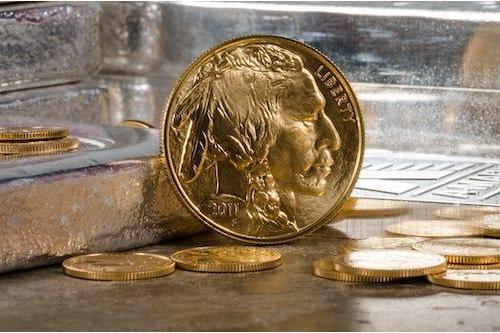
What NOT to Do With Coins
“The most wonderful time of the year” is quickly approaching, and you know what that means. Parties, potlucks and…plenty of time to show off your beloved bullion coins, collectors coins, and investment grade coins.
Stop! Hold it right there!
Any investor worth their salt knows that shielding gold and silver pieces from sharp surfaces and oily fingers is the key to ensuring the health and longevity of their holding. The way to keep the “precious” in their “precious metals.”
Ok, so that was a bit corny. But the bottom line is, you don't want your hard metal investments to fall prey to unwanted, and frankly avoidable, damages.
In following up on last year’s post outlining the DO’s of successful coin handling and storage, this year, we’ve put together a list of DON’T’s to help get you through all your end-of-year festivities – and the (often regretful) shenanigans that come with them.
So here we go – what NOT to do with your coins this holiday season (or any season, for that matter!):
First up, DON’T toss, juggle or otherwise toy with your coins.
In other words, don’t touch them.
We know that less-than-lighthearted family gatherings can often beg for the comic relief of clown-like entertainment. Or at the very least, something enthralling like a coin collection to gawk over.
But coins are not for passing back-and-forth or tossing about willy-nilly. No matter how much Aunt Linda ensures you that she’ll “be careful” or how much Nephew Joey's puppy dog eyes pull at your heartstrings, remember that there could be unwanted consequences for being too forthcoming with your investments.
Our fingers are a mess of acids, oils and tiny bits of dirt and grime, all of which can easily transfer to the surface of coins even through the quickest of contacts. Because high interest often results from a coin’s well-maintained pristine state and intact original luster, any contact with hands or even breath can result in degradation and therefore, decreased returns. There is a caveat. If your coins are of the bullion variety and you are only investing in them for their weight in solid metal, then touching and handling is not a problem. Anything you can do to keep these coins in their best condition is favorable for when you do liquidate your investment.
Precious metals are relatively soft and impressionable materials, meaning the surfaces of coins are particularly susceptible to pressing, poking and prodding. Especially for rare and investment grade coins, even the slightest fingerprint, residue spot, or worse, nick in the surface of the coin can significantly reduce its tip-top condition and long-term desirability. Not all investment grade coins are placed in a slab. If you purchased a raw proof bullion coin is it is very important to handle with care.
If you do find yourself caving and letting Uncle Bob pick up one of your prized possessions, just make sure he slips on a pair of white cotton gloves before he goes grabbing! Latex or Nitrile will work, too, and be sure to lay a soft, lint-free cloth on a flat surface to avoid coin rolling or bouncing.
DON’T take coins out of their containers.
Want to avoid temptation altogether? Leave your coins where they are!
Apart from the ugly risks noted above, removing your precious metals pieces from their protective flips opens the door to damages from dropping or scratching.
Knowing that gold, silver and other precious metals are particularly malleable, dropping coins on hard dining tables or – gasp! – the floor can lead to dents, dings and other deformations. Not a good look and also damaging to returns.
Protective cases are meant to do just what their name implies – protect your investments from unintended accidents. Letting coins bang together in a box can result in unsightly blemishes, and even breathing on them can lead to damaging “carbon spotting.”
It’s also common knowledge in the collecting world that any item preserved in its original packaging maintains significantly more interest than its tampered-with counterparts. This is especially true for graded coins, which are delivered from outfits like PCGS and NGC in air-tight, hard-plastic cases.
These pieces should NEVER be removed from their cases, and the cases themselves should NEVER be tampered with! Doing so could significantly decrease the desirability of your coins, so why go through all the trouble and expense of obtaining a grade if it's just going to be voided entirely because the case has been opened?
Investment grade or not, it’s just best practice not to remove any coin from its protective container.
DON’T spit shine your coins.
Ok, so maybe that’s extreme, but seriously, DON’T clean your coins – by way of saliva or otherwise.
All precious metals begin a process called "toning" once exposed to air (i.e., upon or even before being removed from the earth), which often results in visual alterations to a coin’s surface like coloring or iridescent effects.
Some signs of toning may be visually appealing while others may be less so. But natural toning is to be expected and never warrants the cleaning of coins! Even if you don’t particularly love the look of your aging coins, resist the urge to polish them up. Anything that will diminish or permanently remove a coin’s original mint “luster,” like cleaning your coins with soap and water or even just “shining” them with a cloth, should be avoided at all costs.
If you feel very strongly that your coins are calling for some tender loving cleaning-care, do yourself a favor and consult a professional on the best way to go about it. And then let them handle it!
DON’T stash your coins carelessly.
Once you're done (safely) showing off the fruits of your coin-investing labor, don't merely pile your precious metals in a box and fling them into the abyss that is your attic.
How you store your coins is just as important as how you handle them, and it’s particularly imperative to protect your gold, silver and other metals pieces from drastic temperature changes. Aiming for a stable approximately 75-degree-or-cooler environment is recommended.
Don’t stash coins on a window ledge where the afternoon sun will bake them to a crisp. Don’t shove them right up against a heating vent or radiator. Definitely don’t stack them carelessly in the garage or basement where temperatures fluctuate vastly depending on the month, week or even time of day.
To maintain the utmost care for your coins, finding a climate-controlled space shielded from the elements is your safest bet!
So there you have it, folks. Our handy-dandy guide on what NOT to do with your coins this holiday season (and beyond!). Keep this list in your back pocket, and you'll be that much closer to surviving all the celebration that is sure to ensue!









